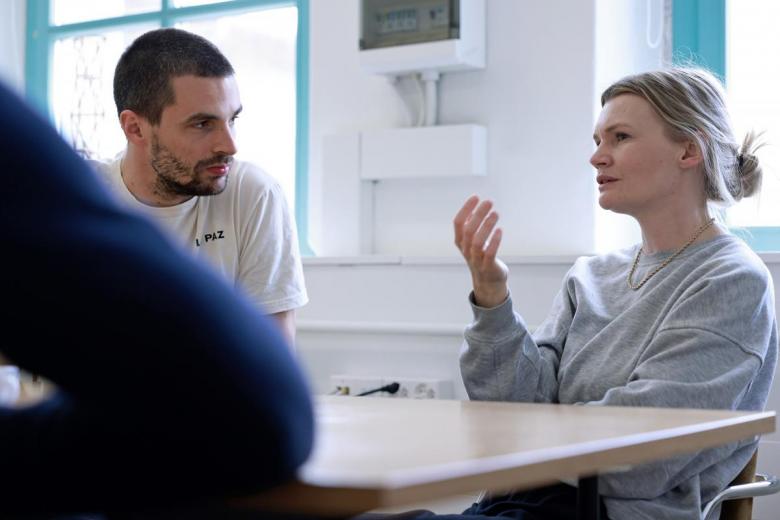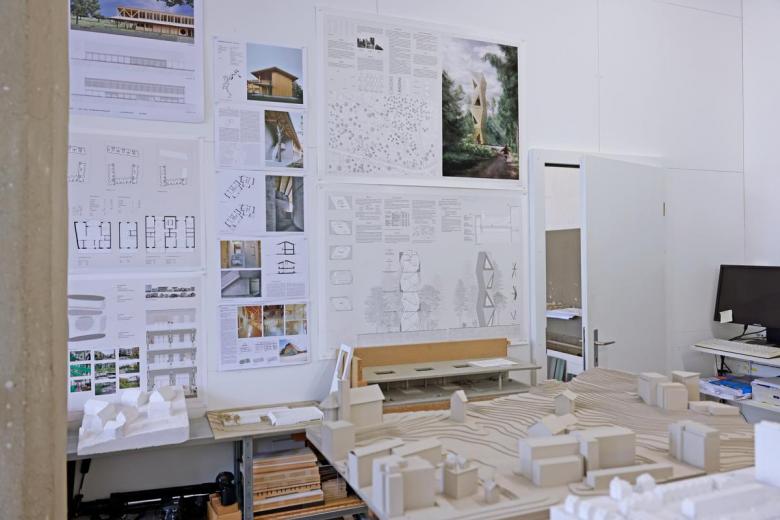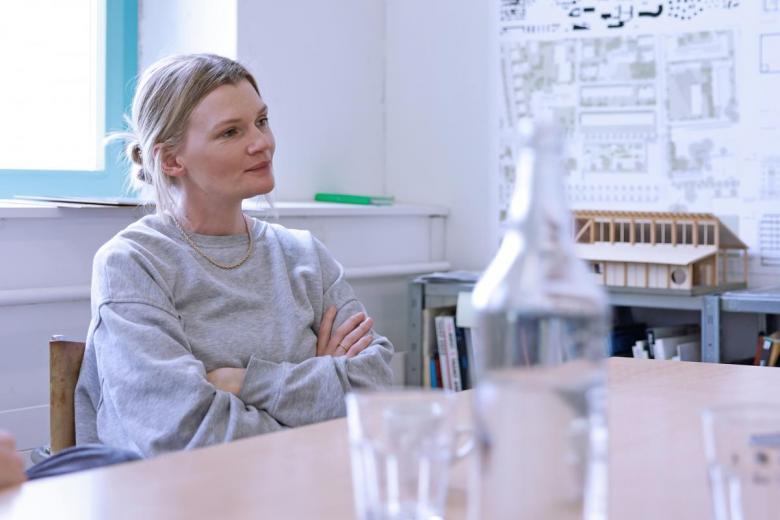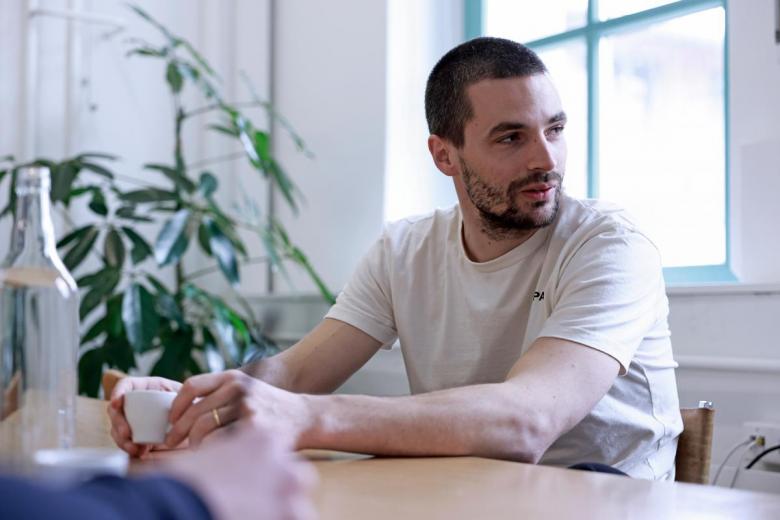Interview with Nadja and Lukas Frei
'Today we often have to contend with the misconception that a building is environmentally friendly just because it is built of wood'
With their lookout tower in the Hardwald recreation area near Zurich, Nadja and Lukas Frei of Luna Productions have won our readers' choice for the Swiss-Architects Building of the Year. Who are these two, what is their approach, and how do they work? Elias Baumgarten spoke with the architects in their studio in Deitingen.
Nadja, Lukas, congratulations on winning our readers’ poll for Building of the Year. Your lookout tower in the Hardwald recreation area received over 24 percent of the votes — a resounding victory. This clear result was possible thanks to great public support. Many architects want their buildings to appeal to everyone, not just their colleagues. How did you achieve this?
Nadja Frei: The local people came into contact with the project at a very early stage, starting with the architectural competition. Later on, we deliberately turned to local or at least regional craftsmen and used only wood from the Hardwald forest. The connection with the location became the common thread of the project. Perhaps this is why many people can identify so well with the tower and see it as their structure.
Lukas Frei: It was also important to us to design a meeting place for the five communities of Opfikon, Kloten, Wallisellen, Bassersdorf, and Dietlikon, not just a lookout tower. We aim to bring people together with our architecture. Another point is that the Hardwald is very popular. People go there to enjoy their free time. So, many people visited the construction site several times, and they were already very interested during the construction period; public attention was further increased by many reports in the local media.
Besides, you've managed to create a very aesthetic building. The perspective effect is impressive: Walking around the tower creates the illusion that it is moving, almost dancing.
Nadja: A tower like this one is something spectacular in itself. During the design process, we quickly realized that perspectives and the geometric shapes are of immense importance due to the height of over 40 meters (131 feet). Much more than usual, we worked with models to develop a deeper understanding of the tower's appearance. Yet despite all the tests on the model, we were surprised and touched when we eventually saw the finished structure and walked up it for the first time.
Well, a lookout tower is not an everyday construction task. Have you nevertheless been able to draw any lessons from it for other projects?
Nadja: In the course of this project we gained a great deal of knowledge about timber construction, even though we are aware that not all of it can be applied directly to more complex buildings such as apartment blocks, which impose much more extensive requirements in terms of both building physics and operation. Today, we often have to contend with the misconception that a building is environmentally friendly just because it is built of wood. This is not quite true. Wood is sometimes used with a lot of effort, glue, and metal, because people try to use wood in constructions where it is not efficient. In the case of the lookout tower, we used almost only raw material: Except for the main supporting structure, the timbers were neither treated nor glued. They can be easily replaced and, if necessary, left to rot in place in the forest.
Lukas: For us, the tower was also a test with regard to the local processing of wood. We only worked with wood from the Hardwald forest, and the sawmill and wood construction company we worked with is located in a neighboring village. Timber construction is much more sustainable if transport routes are as short as possible. Today, unfortunately, wood is often transported hundreds of kilometers before it is used. In most cases, we as architects can only specify that the carpenters use Swiss wood.
Nadja: The social and political aspects of the project were also instructive for us. As Lukas already mentioned, the client was a group of five municipalities. So we had to bring together a large number of people. Ultimately, the success of the project is certainly also based on the good cooperation between the various players.
For me, the Fleur de la Champagne residential and commercial building in Biel, on which you are currently working, continues much of what seems to have been considered in the tower project.
Lukas: It would be great if this project really gets to the heart of our design approach. It is important to us to develop architecture that brings out the characteristics of the site and distinguishes it, but above all that it is a place of community, for people and nature. We won the competition in 2021. The complex consists of an elongated six-story building and a two-story building with a roof garden for Stiftung Zentrum SIV, a foundation aiming to integrate people with disabilities into society. The two buildings enclose a communal courtyard. Our goal is to accommodate living and working in a community-promoting, sustainable and flexible development, and to offer a home to people with very different lifestyles.
Nadja: Public uses include a neighborhood store, a pub, a mobility station and coworking spaces. Workspaces and apartments for people with disabilities ensure inclusion and diversity. Arcades provide access to the apartments and communal areas, and we have designed them so they can be used as meeting spaces. There will be different types of apartments ranging from studios to cluster apartments. Rooms that can be rented as needed are also envisaged. In addition, we have provided many options for the residents to extend and adapt the apartments themselves.
Lukas: Moreover, the timber construction is designed to be completely climate-neutral. We want to use many recycled building components and natural building materials. And we are also striving for consistent system separation, which will make it easier to recycle the building materials later on.
Your office is in a very rural area, in Deitingen near Solothurn, between Zürich and Bern. House vis-à-vis, one of your first successful projects, is also located there. What is the quality of architecture like in the countryside?
Nadja: That's hard to generalize, but we have the impression that the understanding of architecture in the countryside is sometimes different from that in the city. If you look at what's being built in the countryside, it's sometimes disillusioning.
Lukas: Institutions and public-sector bodies mainly focus on the quality of spatial planning and architecture in metropolitan areas. Less attention is paid to quality developments in rural areas. It seems to me that political answers are still lacking here. In addition, there are few experts available in the countryside. Many commissions are staffed by laypeople.
How could the situation be improved?
Nadja: It takes openness and commitment. Talking to each other helps a lot. If there were just two or three people in each municipality who take care of things, already that would make a difference. I try to do my part by getting involved in the planning commission here in Deitingen. We have also organized village walks to explain the village-scape protection zone and to discuss what is worth preserving and why. In addition, I would like to see building in rural areas given more attention at universities, as is already the case at some universities of applied sciences. And the best thing would probably be if more architects got involved in politics. For what is needed is commitment at a superordinate level; individual good buildings do not change the overall situation.
Lukas: Our village walks were well received. People are interested — but often only as long as it does not concern one's own plot, one's own "Gärtli" (garden). Unfortunately, the big picture is often missing, and people too often only look after themselves.
Nadja: For many people, such events open up a new perspective and a new view of the village and our built environment. They develop a better understanding of issues relating to building culture, such as the protection of the villagescape, which I have just mentioned. Again and again, lively discussions arise. That is very valuable.
That sounds like a lot of groundwork. What are the advantages for architects in rural regions?
Lukas: Most of our commissions are awarded through competitions. So it doesn't matter whether your office is based in the countryside or in a big city.
Nadja: We probably benefit from the fact that people know us as an office in the country. Many people can relate to that. In Zurich, for example, we would be just one of many young offices. It would probably be more difficult to make a name for ourselves there. In the Solothurn region, there are only a few young offices. We had the opportunity to participate in study commissions early on, even though we didn't have any reference projects at the time.
Lukas: It must also be said, though, that the location also has certain disadvantages. For example, it is much more difficult to find interns or employees. Many young architects are attracted to cities.
Let's skip to another topic: I like seeing your kids play in the office. How do you balance parenting and work?
Nadja: We live upstairs and our office is on the ground floor. Work and family life merge with each other; that might not be for everyone, but we like it that way. Despite the intensive job, we enjoy a very fulfilling family life: having meals together and everything else that goes with it. We can be there for our kids, need be, and they often spend time with us in the office.
Lukas: We don't have a situation where one of us works night shifts in the office while the other one looks after the children and does the housework. We both work 80 percent and equally share childcare and office work. That makes it easier to juggle everything. Fortunately, we are also supported by our family.
The architectural profession is extremely time-consuming. To what extent do you need family life as a balance to maintain a healthy equilibrium?
Lukas: Good architecture is not created without life. It needs muse. I need to play with my kids so that I'm inspired when I get back to work.
This brings me to asking you about your sources of inspiration.
Nadja: For me, analysis plays an important role. When I deal with a new building task, I delve very deeply into the needs and lives of the future users. That can be very inspiring.
Are you less interested in architectural history and theory?
Nadja: We also consult architecture books, of course. However, it's topics from related disciplines, from art and culture, and sometimes also from sociology that inspire us, rather than building history and architectural theory. We have more of a historical interest in traditional craft techniques: How was wood processed in the past? How was it cut? What were the processes like in the sawmills?
Lukas: Discourse among ourselves is also something we value very highly. Since we spend so much time together and are almost always together, we are constantly exchanging ideas about architecture. As soon as one of us thinks of something or notices something in everyday life, we talk about it. That keeps us moving forward.
Nadja Frei studied architecture at the Bern University of Applied Sciences in Burgdorf. In 2014, she founded Luna Productions together with Lukas Frei, having previously realized various projects of her own. From 2011 to 2018, she worked as an architect at Guido Kummer + Partner. Since 2020 Nadja Frei has been a member of the Deitingen planning commission and since 2022 also of the design advisory board for the development of the Attisholz site in Riedholz.
Lukas Frei studied architecture at the ETH Zurich and Bern University of Applied Sciences. During his studies, he completed various internships in architectural offices but also in craft businesses.
This interview was originally published on Swiss-Architects. Translation by Bianca Murphy.








